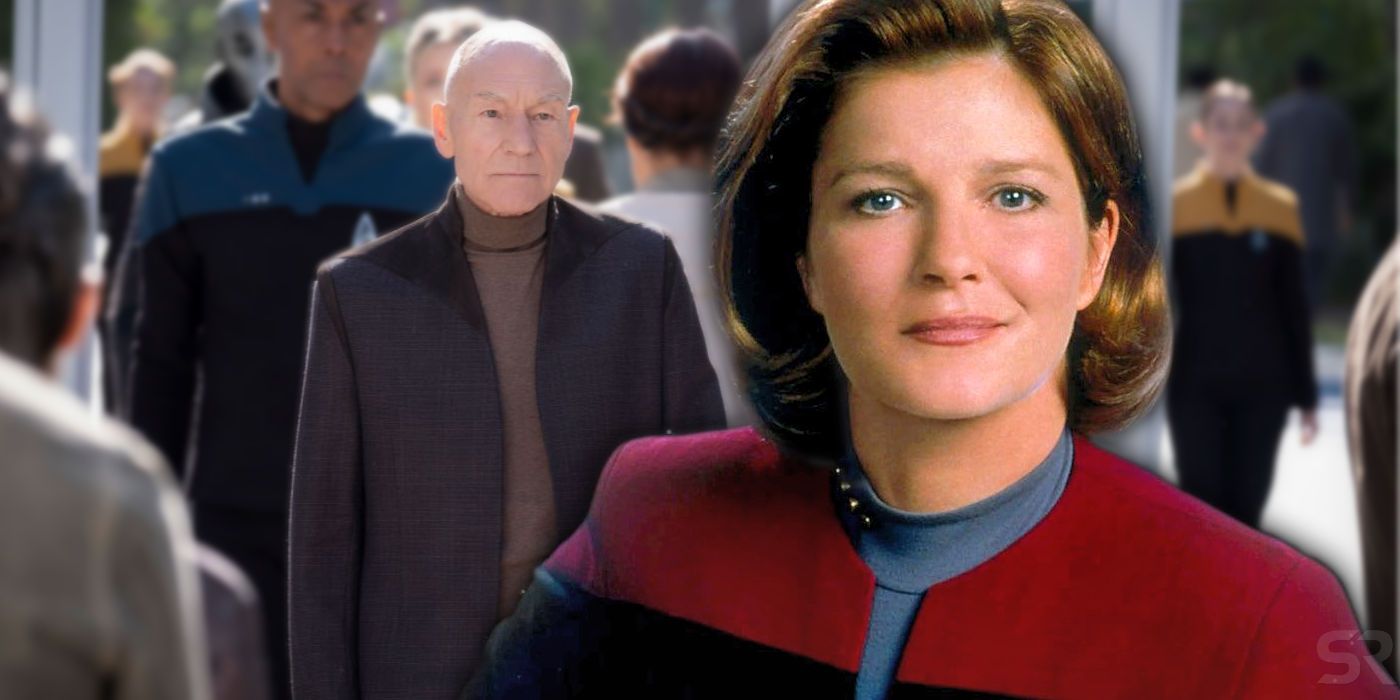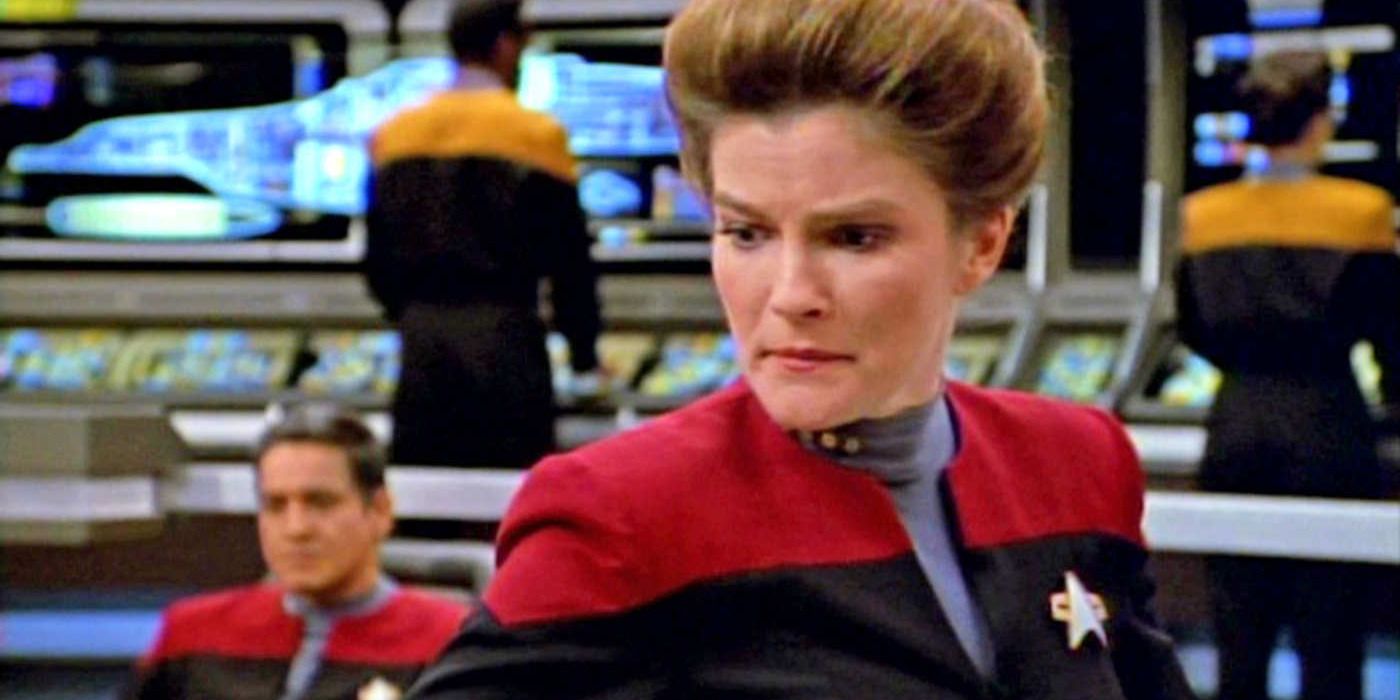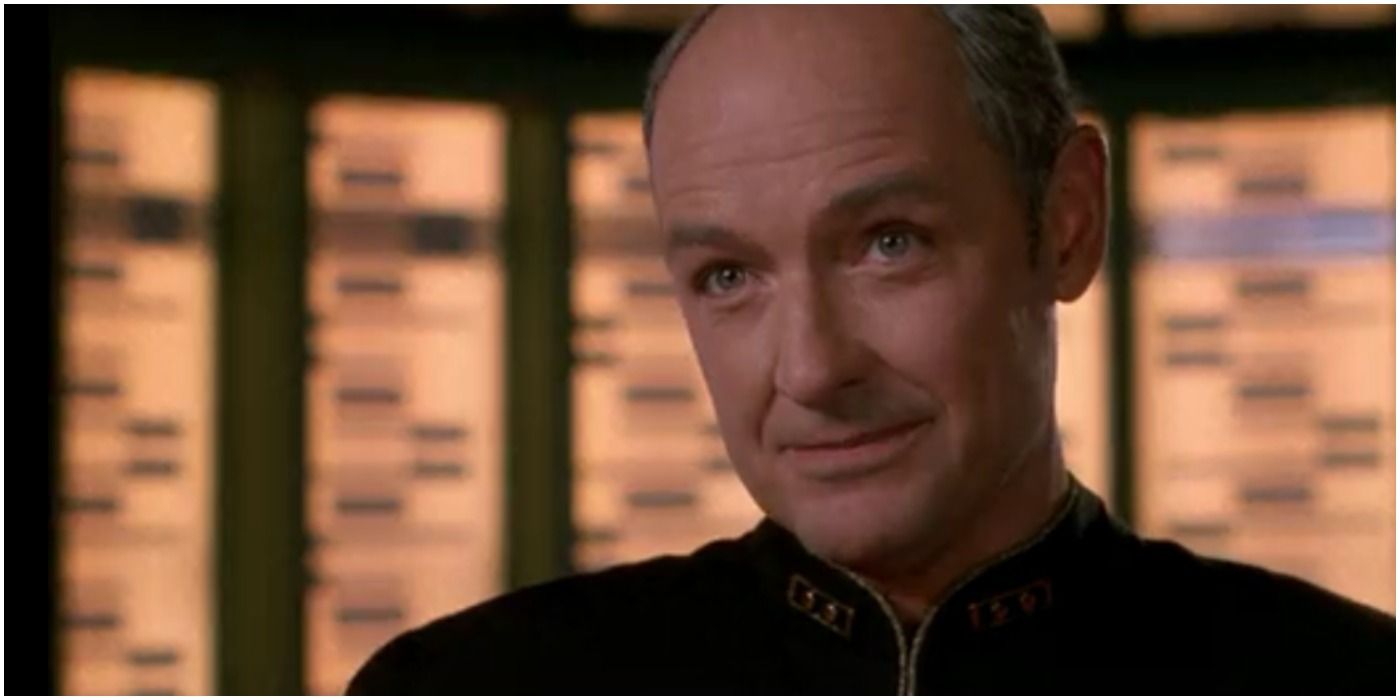Star Trek: Picard had a prime opportunity to showcase Star Trek: Voyager's Kathryn Janeway, but smartly went in another direction. In the series' second episode, "Maps and Legends," Jean-Luc Picard finally decides to seek help from Starfleet in his new mission to find Bruce Maddox and save Soji. Picard meets with the Starfleet Commander in Chief, Admiral Kirsten Clancy, a middle aged woman with more than a few surface similarities to Janeway.
However, Clancy strongly rebuffs Picard's request to be reinstated, justifiably angered at his interview in which he lashed out at Starfleet for their inaction in the Romulan supernova catastrophe following a synth attack on Mars. It's a jarring scene, with Clancy actually dropping an F-bomb at Jean-Luc's perceived arrogance, assuming he could waltz into Starfleet Command over a decade after resigning in protest and grab a quick starship and crew. But more than that, Clancy is the embodiment of Starfleet's newfound cowardice, hiding behind the pretense of bureaucracy to justify the inaction that caused the deaths of countless millions.
Picard loses his cool when met with Clancy's amoral rhetoric and is unceremoniously thrown out, signaling that Starfleet are not going to be the heroes of the story Star Trek: Picard is interested in telling. So why not bring in Janeway for that scene? There are answers that are both obvious and a little bit complicated for that.
Janeway Isn't A Villain
Kathryn Janeway is a unique figure in Star Trek lore. Not only was she the first female captain to anchor a series, she also had a slightly different moral code than most of her fellow starship commanders. Trapped decades away from home in the Delta Quadrant, Janeway and her Voyager crew became more like a family than a military unit, occasionally shirking Starfleet regulations in an effort to protect their own and get home. Captain Janeway was also known to bend the rules on occasion, even making a cabal of former Maquis soldiers integral parts of her crew, including her first officer, Chakotay. And it's hard to imagine Stafleet signing off on bringing in a former Borg clone, Seven of Nine, as a full on member of Voyager's crew.
Janeway also stepped right up to the line of irresponsibility on numerous occasions, often making wild gambles at her own expense in desperate situations, all in an effort to guarantee the safety of her crew. She is perhaps the biggest wild card in Star Trek history, taking risks that seemed unnecessary on more than one occasion, but always with a benevolent purpose. She represented the free wheeling, cowboy diplomacy of Captain Kirk much more than the measured, intellectual approach of Captain Picard.
We do know that Janeway and Picard have something of a pre-existing relationship. In Star Trek: Nemesis, the final film to feature the cast of Star Trek: The Next Generation, newly promoted Admiral Janeway issues Picard and the Enterprise their orders to meet Shinzon on Romulus. The relationship was obviously one of respect and warmth, a million miles way from the open contempt Clancy clearly holds for Picard. It's hard to imagine Janeway signing off on Starfleet's cowardice in the face of Romulus' destruction, or dressing down Picard in such utterly devastating fashion when his mission is clearly one designed to save lives, even if it might be politically inconvenient.
Starfleet Admirals Are Usually Jerks
For such a Utopian organization, Starfleet really has a tough time finding competent leaders. There's a long, rich history of the Starfleet admiralty being stocked with incompetents and outright corrupt criminals. In the TNG episode "Ensign Ro," Admiral Kennelly very nearly bathed Starfleet's hands in Bajoran blood because he was too dumb to realize he was being manipulated by the Cardassians. In "The Offspring," Admiral Haftel threatens to separate Data from his first daughter, Lal, for specious reasons; Captain Picard was ready to sacrifice his career to keep Data and Lal together, but the latter tragically died before the matter was settled, though obviously that episode foreshadows the situation Picard now finds himself in with Soji and Starfleet. Admrial Pressman let countless crew members die in an effort to develop an illegal cloaking device in "The Pegasus." Admiral Nechayev was seemingly invented as an obnoxious human roadblock for Picard in TNG's later seasons. Star Trek VI: The Undiscovered Country revolves entirely around a criminal conspiracy involving the higher ranks of both Starfleet and the Klingon Empire.
But perhaps most pointed here is the classic TNG episode "The Drumhead." After Admiral Norah Satie is dispatched to look into an explosion on the Enterprise, her investigation quickly devolves into a paranoid, McCarthy-esque witch hunt, finding phantom Romulan conspiracies around every corner. Picard is eventually able to expose Satie for what she is, but not after one man's Starfleet career was needlessly left in tatters when it was revealed that he had a Romulan grandfather. In the aftermath, Worf is left disgusted with his own actions, as he helped Satie wrongly persecute a man. Picard's words in that scene echo loudly through Star Trek: "She or someone like her will always be with us, waiting for the right climate in which to flourish – spreading fear in the name of righteousness. Vigilance, Mr. Worf. That is the price we have to continually pay."
Somewhere along the way, Starfleet lost sight of that vigilance, and has allowed itself to be hollowed out by fear and mistrust. Some fans may take umbrage at the idea of Starfleet and the Federation stumbling into isolationism, but the notion of a Utopian future was never something Star Trek said was guaranteed or would require no work. Clearly there have been bad actors throughout Starfleet's history, back to the days when Kirk scoffed at the bureaucratic leanings of his superiors. It's not a huge leap to think a galactic catastrophe, like the attack on Mars, could shake a Utopian society to its core, resulting in some unfortunate knee jerk reactions that led to the dismissal of men of good conscience like Picard.
But it's too much of a stretch to think Kathryn Janeway would allow such moral rot if she were still in a position of power in Starfleet. Janeway may have been happy to bend the occasional rule or even break one of it meant saving the lives of those she cared about, but signing off on what essentially boiled down to the passive genocide of the Romulan people is something she would never stand for. Fans certainly would have been delighted to see Kate Mulgrew in uniform for that scene with Picard - they are equally excited to see a seemingly much different Seven of Nine in upcoming episodes - but it would have betrayed what the character was really about in favor of cheap fan service. Janeway deserves better than that, and the creation of a new character to dole out Starfleet's new questionable ethos was the right choice for all involved. It shows that the producers of Star Trek: Picard understand these characters and aren't willing to throw nostalgia against the wall in an effort to foster goodwill. Star Trek: Picard is good enough and honors what's come before in respectful ways so that it doesn't have to use such cheap tricks. Sometimes restraint is the best path forward, especially when it comes to reintroducing - and perhaps redefining - some of the characters from previous iterations of Star Trek.



